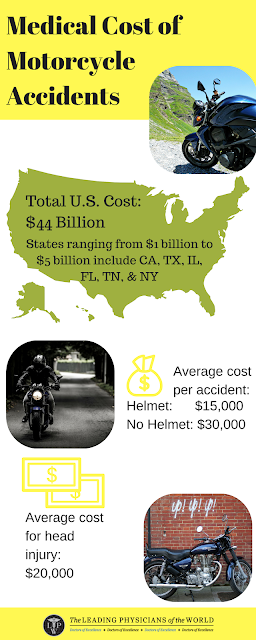Medical Cost of Motorcycle Accident
Believe it
or not, you're thirty times more likely to die in
a motorcycle accident than in an automobile crash. As a rider, you're
bouncing around at high velocities in close proximity to stationary objects and
machines many times your mass. In a best-case-scenario, going off-bike will see
you vying with pavement, other vehicles and your own bike with nothing to
protect you but some Kevlar, a little leather and a bit of Styrofoam.
According to the Government Accountability Office, 82,000 riders were injured in motorcycle accidents and 4,502 individuals were killed in crashes. All told, the immediate cost of those downs was $16 billion or more. On average, a fatal motorcycle crash costs around $1.2 million, with non-fatal incidents carrying a price tag of anywhere from $2,500 to $1.4 million depending on rider injuries.
The
most-studied topic in motorcycle safety is the efficacy of helmets in
preventing and mitigating head injuries. The link between head injury and
riding without a helmet is by now well established. Little research has been
published, however, on helmet design. Other sorts of safety equipment, notably
protective clothing for riders, are less studied. Other factors in motorcycle
safety include alcohol intoxication and the roles of rider training and experience.
Both of these issues have received some attention in the literature, but much
less than helmets.
A further
dimension in motorcycle safety analysis of interest for public policy is the
cost of motorcycle crashes, especially as this cost is borne by the public. It
is easy enough to determine the costs of various safety equipment and programs,
but it is more complex to determine the costs that are saved when injuries are
prevented or mitigated by successful safety measures. The major types of costs
resulting from injury are 1) the cost of medical treatment, 2) the value of
lost work, and 3) decreased quality of life. Most of the publications made some
effort to look at short-term medical costs. But few looked at long-term medical
costs or work loss, and only two considered quality of life. Accurate medical
cost estimation is complicated by institutional factors that differ between
states -- and sometimes between hospitals or payers. The other costs are
difficult to ascertain because their computation requires information from a
lengthy follow-up period after the crash, particularly in cases where the
victim is permanently disabled.
The review,
conducted by the National Highway Traffic Safety Administration, looked first
at the average hospital charges associated with motorcycle accidents. In cases
where riders survived the accidents even though they were not wearing helmets,
average costs ranged from over $7,000 to $30,000. Treatment in a trauma center
was generally more expensive than hospital or emergency department treatment.
Even those riders who were wearing helmets were left with average costs
hovering around the $15,000 range.
Helmets
offer some limited protection against head injuries, so the review also
narrowed in on average hospital charges in cases of head injuries. Treatment of
a head injury at a hospital generally totaled in the $20,000 range, while a
trauma center could reach as high as $43,000. However, even a motorcycle
accident victim who does not suffer a head injury could expect to pay between
$10,000 and $15,000 for treatment.
The review
noted that victims generally do not bear most of these costs themselves; on the
other hand, the government and private insurers do. Insurance companies in
particular may not always be forthcoming with full compensation for a victim's
losses. Even if hospital or trauma center charges are covered, there are other
long-term costs associated with a head injury, brain injury or permanent
disability. Obtaining full compensation for one's losses may require legal
action.
So, what
would be the solution? According to the GAO, the only measurable way to cut
those costs is to mandate helmet use. Helmets reportedly cut the fatality rate
of motorcycle crashes by 39 percent, and the National Highway Traffic Safety Administration claims helmets prevented 1,550
deaths in 2010. Likewise, the Center for Disease Control says the lids saved
the economy a total of $3 billion in those crashes.




Comments
Post a Comment